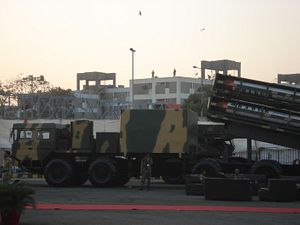Pakistan continues to have a slight edge over its archrival India in the number of nuclear warheads, the Stockholm International Peace Research Institute (SIPRI) revealed in its annual nuclear forces data, which outlines recent trends and developments in global nuclear arsenals.
According to the data compiled, Pakistan allegedly has 110-130 nuclear warheads, whereas India possesses 100-120 nuclear warheads. Islamabad and New Delhi are both in the process of expanding their nuclear weapon arsenals including missile delivery capabilities, the report notes.
“Despite the ongoing reduction in the number of weapons, the prospects for genuine progress towards nuclear disarmament remain gloomy,” comments Shannon Kile, Head of the SIPRI Nuclear Weapons Project. “All the nuclear weapon-possessing states continue to prioritize nuclear deterrence as the cornerstone of their national security strategies.”
Neither Pakistan nor India are thought to have deployed any of their nuclear warheads, but are keeping their nuclear warheads de-mated from the actual missiles. Both countries purportedly keep their warheads in central storage. India’s nuclear warfare policy is centered on a No First-Use (NFU) doctrine. Pakistan, however, refuses to adopt a NFU doctrine but has indicated time and again that it would hesitate to use nuclear weapons first.
As I reported last August, Pakistan, within the next ten years, could possess the third-biggest nuclear weapons stockpile in the world, based on a research report compiled by two U.S. think tanks. “Pakistan operates four plutonium production reactors; India operates one. Pakistan has the capability to produce perhaps 20 nuclear warheads annually; India appears to be producing about five warheads annually,” the study notes.
Pakistan could “have a nuclear arsenal not only twice the size of India’s but also larger than those of the United Kingdom, China, and France, giving it the third-largest arsenal behind the United States and Russia,” last year’s report reads. “Many observers have concluded that Pakistan’s rate of fissile material production (and assumed construction of nuclear weapons) gives it the fastest-growing nuclear weapons stockpile.”
As mentioned above, one of the principal reasons why Pakistan is outperforming India is because it is dedicating more fissile material to the production of nuclear weapons, according to the 2015 Carnegie Endowment for International Peace/Stimson Center report:
In terms of total stockpiles of plutonium and HEU [highly enriched uranium] for nuclear weapons, India has about 600 kilograms of plutonium, while Pakistan has about 170 kilograms of plutonium and 3.1 metric tons of HEU. Assuming that each nuclear weapon would require five kilograms of plutonium or 15 kilograms of HEU, with existing stockpiles of fissile material India could theoretically construct up to 120 weapons, while Pakistan could construct up to 240.
However, India continues to possess the larger stockpile of plutonium, providing it with an edge over its rival:
Plutonium is in most respects more desirable than HEU as a material for nuclear weapons, given that less of it is required for an equivalently powerful fission bomb, which makes plutonium warheads lighter and more suitable for delivery by ballistic missile.
The SIPRI report highlights that the overall number of nuclear weapons continues to decline. Nevertheless, the United States and Russia–which together still possess 93 percent of all nuclear weapons—have launched major modernization programs over the last two years.

































